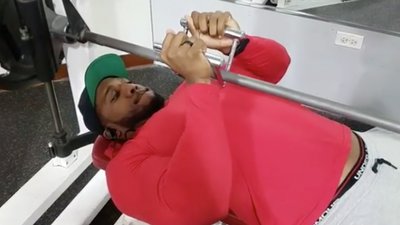Necessity is the mother of invention, both inside the gym and out. So when Bodybuilding.com athlete and fitness model Lawrence Ballenger injured his pec benching 200-pound dumbbells recently, he got creative. His goal was to get through rehab without losing too much chest size. To make it happen, he dropped the free weights and went to the machines.
Luckily, using machines in creative ways is nothing new to Ballenger. Here are three novel ways he uses common gym stations to keep his workouts fresh, while continuing to build muscle. He's a pro at doing both.
1. V-Grip Smith Machine Press
"This close-grip Smith machine exercise is a great way to get your triceps out of the movement and isolate your chest," Ballenger says. "Position yourself so that you're right underneath the bar, with the bar running right up your sternum between your pectorals. On the way down, spread your elbows apart, and get a really good stretch in your chest. On the way up, keep your elbows tight for a full chest contraction to work the inner part of your chest—an area most people miss."
When performing other Smith machine pushing movements, such as overhead presses or bench presses, you can easily rack the weight yourself. Not so here! Since you're using a row bar, you need a partner to rack the weight. Don't wait until the end of your set to figure this out.
Don't be a hero with weight selection here, either. 3-4 sets of 8-12 reps is about perfect.
2. Biceps Machine Cannonball Sets
Just like he runs the rack with dumbbells, Ballenger and his training partner came up with a way to "run the stack" on the biceps machine. No matter what you call this technique, the end result is the same: a relentless, grinding battle with gravity.
"You can use any number of reps for this; I just happened to choose 10," he says. "Start with the lightest weight on the machine, usually 30 pounds, and do 10 reps. Then, moving the pin down one plate at a time, work your way as far down the stack as you can go until you can't finish 10 reps anymore. When you've reached this point, go back to the top and start down the stack all over again, one plate at a time. All of that equals one set, which can take me anywhere from 3-7 minutes. I usually try to do 2-3 sets with a few minutes of rest in between."
Ballenger has two pieces of advice for this workout:
- Work with a partner who can move the pin for you, allowing you to cram more work into less time.
- Seriously, work with a partner. This way you get an extra-long break between sets while they do their own cannonball sets. You're going to need it.
3. Hamstring Curl Pre-Exhaust for Squats
Most lifters do isolation exercises for their hamstrings after they've finished heavy-duty multijoint exercises like squats or deadlifts. The hammies have already seen a lot of action by then, so you can't give them much of a workout. Ballenger suggests turning this part of your routine upside down.
"Most people have under-developed hamstrings. You can fix that by getting on the hamstring curl machine before you do your squats," he says.
But don't take this to mean he goes as heavy on curls as on squats! The opposite is true: This is pure pump work.
"I'll usually do 100 reps, one leg at a time. That really gets some blood flowing, and turns what is usually the secondary muscle when you're squatting into the primary muscle to spur development."
As far as what weight to use, Ballenger says to take the load you usually use for hamstring curls and use about a third of that.
"I can normally do 40 or 50 pounds, so I cut it down to 10 pounds for this exercise. It starts out being a very, very light workout. But, by the time you get to 30 or 40 reps, you'll be glad you didn't go any heavier."
If 100 reps feels out of reach at any weight, another of Ballenger's favorite techniques is to alternate legs like this, with no rest:
- Left leg: 10 reps
- Right leg: 10 reps
- Left leg: 8 reps
- Right leg: 8 reps
- Left leg: 6 reps
- Right leg: 6 reps
All of that is one set. Do four sets total. Then do your squats—and consider taking the elevator rather than the stairs for a few days.

